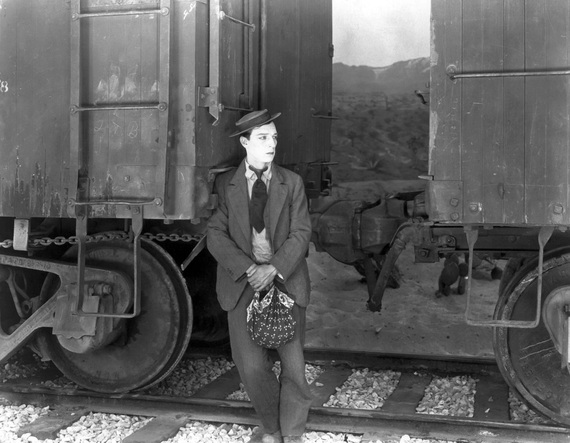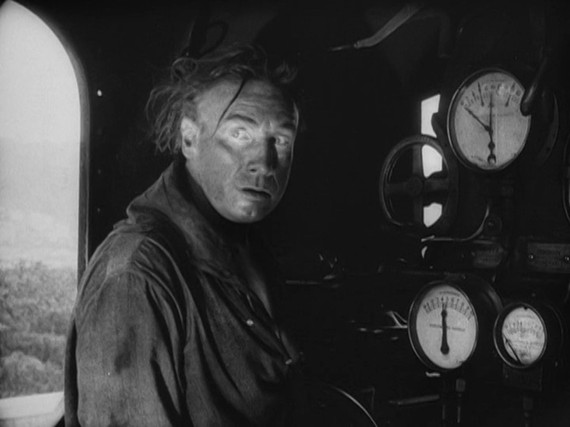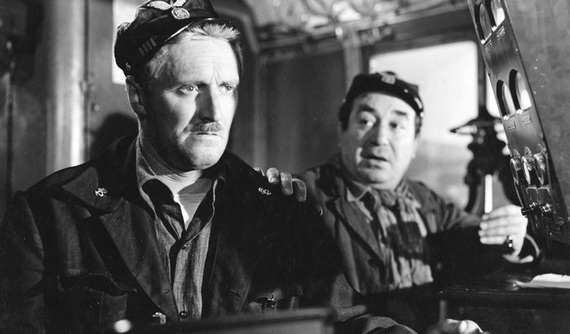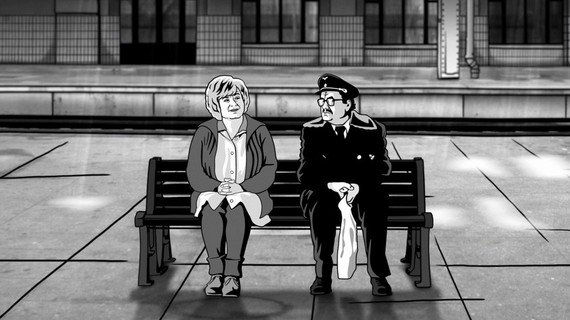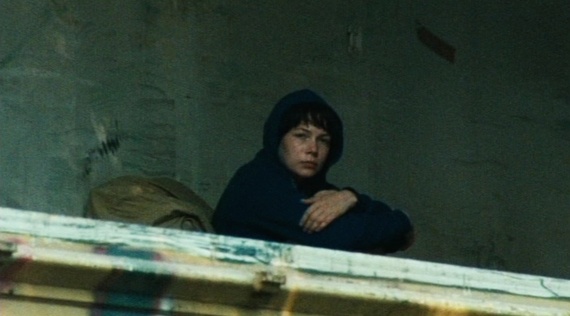Symbols of modernity, nostalgia or doom, sometimes a crucible for love, fear or no-good, trains have proliferated in the motion pictures since that first locomotive pulled into La Ciotat station.
By Shari Kizirian
A seamstress's daughter hops off a streetcar in Moscow, crossing the railroad tracks toward home. Three gunmen wearing dusters kill time on a railway platform in Flagstone. Under the lounge car of a commuter train, a stranger accidentally knocks shoes with another stranger. Meanwhile, a bleached blonde schemer lies in wait for the 9 o'clock from San Francisco, her husband dead in the back seat. Elsewhere, the Doppler effect on the soundtrack raises chill bumps as an engine roars into a tunnel -- ahead a captive might be tied to the tracks, or maybe, a desperate outcast waits for sweet release. Or -- time simply passes, something banal or breathtaking on view in the aspect-ratio window. Sometimes a symbol of modernity, nostalgia or doom, sometimes a crucible for love, fear or no-good, trains have proliferated in the motion pictures as settings, plot devices and metaphors since that first locomotive pulled into La Ciotat station
Go West
A year after John Ford's epic The Iron Horse about the glories and sacrifices of building the transcontinental railroad was America's top-grossing film, Buster Keaton produced this gem about going west as an epic act of humiliation. Broke and alone, Friendless stows away in a freight car full of wooden barrels. When one threatens to roll him out the open cargo door, he seeks safety on a heap of them. He's jostled about, the heap collapses and he gets trapped inside one of the barrels, then he's rolled off the moving train anyway. The train was a staple in westerns and had been at least since the payroll box tempted the cowboy bandits in Edwin S. Porter's The Great Train Robbery. More revisionist westerns like Keaton's were to come, from Sergio Leone's Once Upon a Time in the West through Jim Jarmusch's Dead Man, the railroad playing its questionable part.
La roue
A prolific peddler of cinematic metaphors, Abel Gance achieved an astonishing realism by shooting La roue at the massive classification yards in Nice. "Every member of the company is in constant danger from the incessant passage of trains," someone on the scene said of the shoot. "A watchman keeps constant lookout and rings a heavy bell every time a 'Hundred Tonner' bears down." This danger and tension of the location shoot is palpable onscreen as the hard-drinking company man Sisif goes half mad with incestuous thoughts and tries to use his locomotive to commit suicide. An astonishing catalog of film technique, including the camera mounted on the wheels of the train, the film stood out for its rapid cutting style that served Gance's overriding metaphor (roue is French for "wheel"). Whether the wheels of the train incessantly roll or a traditional circle dance celebrates the coming of winter, La roue's characters spin at destiny's whim.
Il ferroviere
Gance seems to have told the whole story of railway men in one eloquent scene in La roue when the camera tracks round the company store taking in the worn-out faces of the men, just before a drunken brawl breaks out. By the time the neorealists arrived to depict the postwar working class, such fates seem to have changed little. In Pietro Germi's portrait of one engineer's family, the modern world is personified by defiant children and changing roles for women; the railroad is what's old-fashioned. The film's opening scene presages the changes to come. Shot with a camera on the front of the locomotive, we are hurtling into the station. Suddenly, a switch is thrown, shifting the ground under our feet, the train is now headed in a new direction with no letup in speed.
Alois Nebel
After World War II, trains took on a menacing new sheen. The title character of this 2011 animated film spends years bound to the station, witnessing the nefarious uses of the railroad by both the Nazis and Russians. To soothe his mind, he recites the station stops and times. In one spectacular scene Nebel is sitting at his dinner table when a memory is triggered of his mother leaving. Things begin to rattle as the house windows transform into coach windows, and the camera rushes backward until we're clattering full bore down the railroad tracks. The rich black-and-white palette of the drawings lend a gritty atmosphere while the Rotoscoping of the characters produce an overall unease. Nebel's quietly uttered schedules become a substitute litany for the dead or missing, and his unreliable reality a paradigm for life under a police state.
Wendy and Lucy
The lonesome whistling blowing may have passed the point of salvageable cliché in the movies, but the best filmmakers still have found fresh uses for the sounds of the railroad. Kelly Reichardt's screen adaptation of the short story "Train Chorus" is about a down-on-her-luck woman trying to realize the dream of the open road and its promise of a better life. When Wendy's car breaks down in Oregon and her dog Lucy goes missing, it feels like the end of the line. Diffused whistles of arriving trains or the muffled roll of another departure lightly pepper the soundscape, quietly offering an alternative.
The D Train
Set to the waltzing violins of Shostakovich's Jazz Suite #2, Jay Rosenblatt's The D Train is a found-footage Hale's Tour of one man's life, spanning the short distance from the playgrounds of carefree childhood to the park bench of old age. This kinetic collage circumscribes a lifetime into a series of movements -- a crawling baby, a twirling carnival ride, rubbing early morning eyes, crossing an intersection, reaching out to pat someone's hand -- little gestures and great strides that accumulate into a flash-before-your-eyes remembrance you wish had no end.


